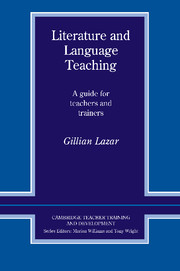Book contents
- Frontmatter
- Contents
- Thanks
- Acknowledgements
- Introduction
- 1 Using literature in the language classroom: The issues
- 2 Approaches to using literature with the language learner
- 3 Selecting and evaluating materials
- 4 Reading literature cross-culturally
- 5 Materials design and lesson planning: Novels and short stories
- 6 Materials design and lesson planning: Poetry
- 7 Materials design and lesson planning: Plays
- 8 Reflecting on the literature lesson
- 9 Literature and self-access
- Answer key
- Trainer's notes
- Bibliography
- Appendix: Eveline by James Joyce
- Index
5 - Materials design and lesson planning: Novels and short stories
Published online by Cambridge University Press: 04 May 2010
- Frontmatter
- Contents
- Thanks
- Acknowledgements
- Introduction
- 1 Using literature in the language classroom: The issues
- 2 Approaches to using literature with the language learner
- 3 Selecting and evaluating materials
- 4 Reading literature cross-culturally
- 5 Materials design and lesson planning: Novels and short stories
- 6 Materials design and lesson planning: Poetry
- 7 Materials design and lesson planning: Plays
- 8 Reflecting on the literature lesson
- 9 Literature and self-access
- Answer key
- Trainer's notes
- Bibliography
- Appendix: Eveline by James Joyce
- Index
Summary
In this chapter we explore some of the distinctive features of the short story and novel. Examining these features will enable us to develop ways of using short stories and novels with our students.
Writing your own story
We begin this chapter by inventing our own story based on the boxed paragraphs below. Before reading any further, cover all of the boxed paragraphs with a piece of paper. You are going to read these paragraphs, which are extracts from a short story, one at a time. At each stage of the reading ask yourself the following questions as a guide to making links between the separate paragraphs:
Who?
Why?
What?
How?
Begin by moving your sheet of paper to the end of the first box and reading the first paragraph. Then ask yourself the questions above, using your imagination to answer them. Move your sheet of paper down to the next paragraph, and ask yourself the same questions. Do this until you have read all the paragraphs and completed the activity.
She sat at the window watching the evening invade the avenue. Her head was leaned against the window curtains, and in her nostrils was the odour of dusty cretonne. She was tired.
She had consented to go away, to leave her home. Was that wise? She tried to weigh each side of the question.
She was about to explore another life with Frank.
Materials design and lesson planning: Novels and short stories
The white of two letters in her lap grew indistinct. One was to Harry; the other was to her father.
- Type
- Chapter
- Information
- Literature and Language TeachingA Guide for Teachers and Trainers, pp. 71 - 93Publisher: Cambridge University PressPrint publication year: 1993

